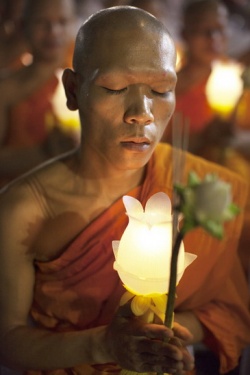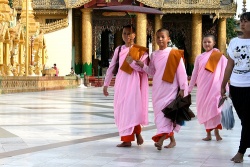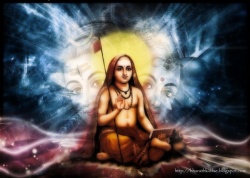Amida
Amida (Japanese): Also known as Amitabha.
The Buddha of Limitless or Boundless Light.
The Buddha who is the main object of devotion in the Pure land school of Chinese Buddhism, and the Jodo and Shin schools of Japan.
Amida
阿弥陀 ( Jpn; Skt Amitayus or Amitabha)
The Buddha of the Pure Land of Perfect Bliss in the west. Amida is the Japanese transliteration of the first half of both Amitayus and Amitabha, names referring to the same Buddha that appear in Sanskrit texts and are rendered in Chinese as the Buddha Infinite Life (or the Buddha of Infinite Life) and the Buddha Infinite Light (or the Buddha of Infinite Light) respectively.
The Sanskrit word amita means infinite.
Amitayus is a compound of this word with ayus, which means life, and Amitabha with abha, which means light.
According to the Buddha Infinite Life Sutra, immeasurable kalpas ago, a certain king, delighted with the preaching of a Buddha named World Freedom King (Skt Lokeshvararaja), renounced the throne to follow him.
He took the name Dharma Treasury (Dharmakara) and began to practice bodhisattva austerities under the guidance of the Buddha.
After examining an infinite number of Buddha lands and pondering for five kalpas, the bodhisattva Dharma Treasury made forty-eight vows in which he pledged to create his own Buddha land upon attaining enlightenment, a land that would combine the most outstanding features of all those he had examined.
In the eighteenth vow, he pledged to bring all sentient beings who placed their hopes of salvation with him (Shan-tao, a patriarch of the Chinese Pure Land school, interpreted this to mean calling upon the name of Amida Buddha) to this Buddha land, which he named Perfect Bliss (Sukhavati), except those who had committed the five cardinal sins and those who had slandered the correct teaching.
Dharma Treasury completed his practice and became the Buddha Amida.
His pure land was established in a part of the universe located "a hundred thousand million Buddha lands to the west" of this saha world.
Belief in Amida Buddha spread from India to China.
After its introduction to Japan, Honen (1133-1212) was responsible for popularizing it there and establishing the Pure Land (Jodo) school.
See also Nembutsu; Pure Land school.
Amitabha (S): Tibetan: Opame. "Boundless Light."
The Buddha of Limitless Light, Lord of the Lotus Family (Padma); one of the Five Dhyani Buddhas, the fourth and most ancient of the five Transcendental Buddhas that embody the five primordial wisdoms.
He presides over the Western Buddha realm Sukhavati (Tibetan: Dewachen, "Pure Ground of Great Bliss"), which is the expression of his own field of compassionate wishes, pure heart and nothing else.
Having manifest a place of awakening accessible to all beings, it is the special vow of Amitabha that in order to benefit beings who are caught in the realm of their own confusion and suffering, one must only remember his name with faith at the time of their death to take rebirth in Dewachen.
Through this birth they will easily achieve enlightenment and not again fall into a realm of suffering.
This is due to the merit-power of Buddha Amitaba’s virtuous activities accumulated throughout countless lives as a bodhisattva.
Amitabha is the pure expression of the wisdom of discriminating awareness, which transmutes the poison of attachment and desire.
He and the other Lotus family members support the gradual unfolding of one’s spiritual petals into enlightenment.
The embodiment of compassion and wisdom, he is depicted as sitting in the lotus posture upon a great lotus blossom throne (symbolizing primordial purity), his body radiating the color of the ruby and clothed in monastic attire. His hands are in the Meditation Mudra,
(the right hand rests on the left hand above the lap with the tips of the thumbs touching), and holding an alms bowl.
Embodying the Wisdom of Discriminating Vision, he transmutes mundane perception into inner vision.
In some mandalas, Amitabha is depicted in union with his Wisdom Consort Gokarmo, who embodies the pure element of fire.
The eminent bodhisattva Avalokitesvara (Chenrezig) the Bodhisattva of Compassion is an emanation of Amitabha.
In China, Amitabha and his Buddha land are described in the Smaller Pure Land Sutra and the Greater Sukhavati Sutra.
A third Sutra was written in China, entitled the Visualizations of the Buddha of Infinite Life Sutra.
This pertains to another reflex of Amitabha known as Amitayus.
These Sutras, as well as others such as the Aksobhya Buddha Sutra, served as the central scriptures for a populist practice intended for lay Indian Buddhists incapable or uninterested in delving into the intricate philosophies and meditations of monastic Buddhism.
Although there is no evidence that they were the center of any organized sect of Indian Buddhism, when these Sutras were translated into Chinese,
a cult soon developed around them which would blossom during the Tang dynasty (618-907 AD) into a full fledged sect of Chinese Buddhism, called the Pure Land.
This sect has continued to influence Chinese Buddhism to this day, as it has been absorbed into the Ch’an schools.
In Japan Pure Land adherents would remain independent from other traditions, competing with populist sects such as that of Nichiren, and splintering into several sub-sects.





